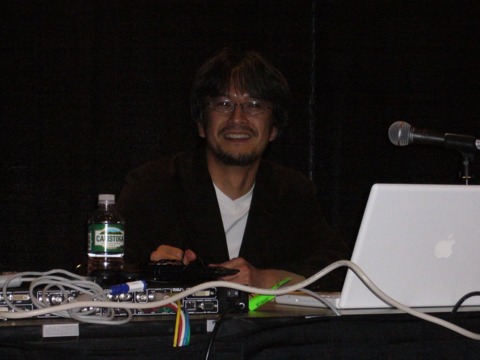GDC 07: Aonuma reflects on Zelda
Nintendo manager of software development says Wind Waker nearly killed the franchise; devs tried first-person combat for Twilight Princess.
The Legend of Zelda: Twilight Princess was almost the last-ever Zelda, Nintendo's manager of software development, Eiji Aonuma, said. Speaking through a translator, he told how the previous game, The Legend of Zelda: The Wind Waker, hadn't been hugely popular in Japan, although it had been reasonably well received in the West. One of the reasons for this was that the Japanese market in general was moving away from games, he said, and this was well publicised and known as "gamer drift."
So, to make a successful game that would appeal to this disenchanted audience and continue his beloved Zelda series, Aonuma said, "We needed a new style of gameplay to breathe life into the market."

Aonuma was speaking at the Game Developers Conference in a talk titled "The Legend of Zelda: Twilight Reflections in the Hourglass." The event was hugely popular, and before he started the talk, Aonuma posed for photos and signed autographs while a long line of attendees filtered in hunting for seats in the hall.
The company found that Wind Waker's cartoon-like graphics were alienating the lucrative teen audience in North America, who would look at games of that style and think they were for kids, he continued. With the Japanese market in the midst of the dreaded gamer drift, and the North American market much stronger, Nintendo decided to give the US what it wanted--a realistic Zelda. He said, "We had to make a game that met expectations of fans in North America. If it didn't, it could mean the end of the franchise."
The decision was also made for Link to have the ability to turn into a wolf. "This kind of disruptive breakthrough was just what we needed for the staff to change their way of thinking."
But still, the game needed something more, something to make it truly innovative. It was around this stage that Aonuma was talking to Nintendo senior managing director Shigeru Miyamoto, who told him something along the lines of, "It's as though the Revolution (later renamed the Wii) was designed just for Zelda! Why don't you try making a Zelda for the Revolution?" In the end, believes Aonuma, the kind of direct control offered by the Wii Remote was exactly what was needed to breathe life into the game.
So the decision was made to bring the game to the Wii. "Creating a launch title was a first for the Zelda franchise, and we had no idea what a challenge it would be," he told the audience.
The company also felt strongly that it did not want to disappoint all the GameCube owners who had been waiting patiently since the game's announcement back in 2002, so it decided to push the game back to 2006 to be able to release it on both formats.
Developers experimented with switching to a first-person session for Twilight Princess' combat sequences with Link's sword movements being controlled by moving the Wii remote. However, it soon became apparent that there was a fundamental problem with this idea. "Link is left-handed, so when a right-handed player swings the sword, it felt awkward...so we abandoned the idea." In the end, the problem was partly resolved by flipping the world laterally to make Link right-handed.
Aonuma said he realised that the game was a success when, "I saw some of our female employees swinging a sword to defeat a huge monster. Then I was convinced Zelda had been reborn."
He also filled in some gaps on the upcoming Nintendo DS version of the series--The Legend of Zelda: Phantom Hourglass. There will be a Wi-Fi-enabled battle mode nicknamed Wi-Fi Hide and Seek. The game is a Pac-Man-style chase, with two players taking on red and blue versions of Link.
Players must pick up "force gems" to see the positions of the phantoms on the board. However, carrying these also has a penalty--they will slow the player down, making it easier for the player to be caught. The other controls the phantoms, using the stylus to move them around to chase Link and hopefully bring him down. Aonuma commented, "The more you play, the more you get to experience the other player's habits, so it's very addictive."
Got a news tip or want to contact us directly? Email news@gamespot.com
Join the conversation